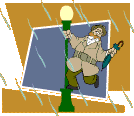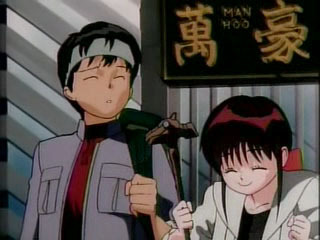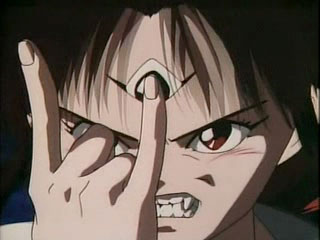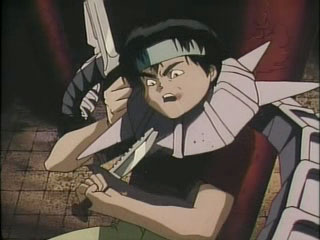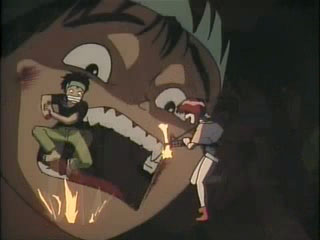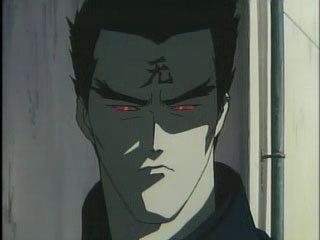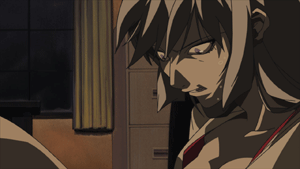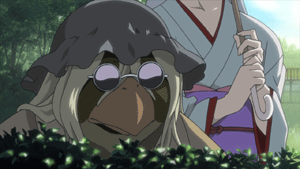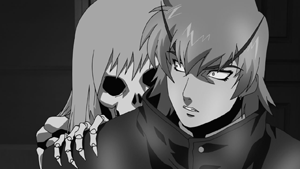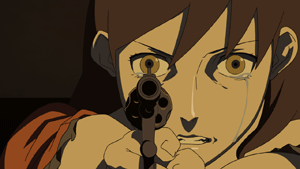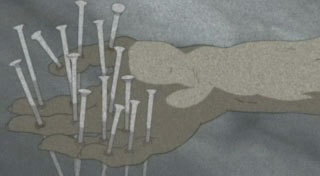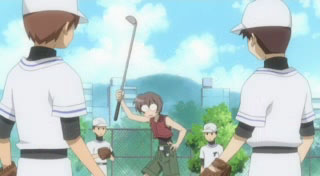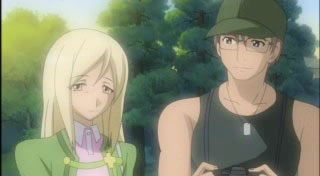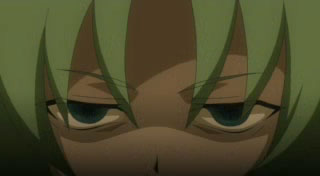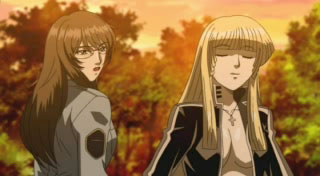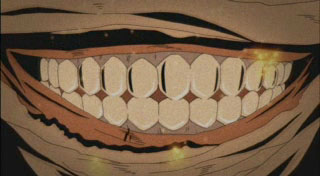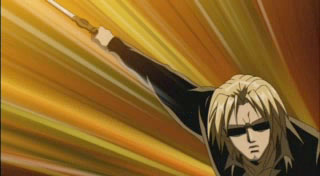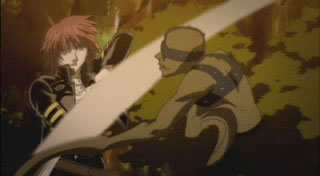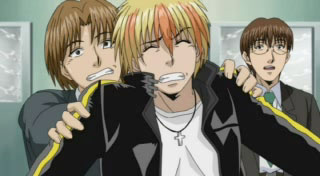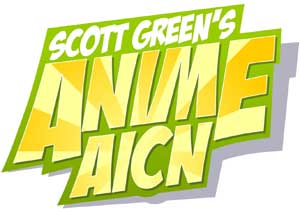 Logo handmade by Bannister
Column by Scott Green
Logo handmade by Bannister
Column by Scott Green
Eye Full of Horror Part 1-Introduction, Demon Prince Enma, The Drifting Classroom and Princess Resurrection Eye Full of Horror Part 2-When They Cry Eye Full of Horror Part 3-Hellsing Ultimate and Ayakashi

Anime Spotlight: 3x3 Eyes Volume 1: Immortals Released by Geneon
3x3 Eyes is an artifact of the glory days of direct to video OVAs, when there was a market for anime that visited a concept for a few, nicely budgeted episodes. Rather than attempt to adapt an entire manga series, many OVAs would offer a highlight or representative sample, an that's the case with 3x3 Eyes. Yuzo Takada's (Blue Seed, All Purpose Cultural Cat Girl Nuku Nuku) horror action manga ran from 1987 through 2002 in Young Magazine, the home of Akira and Ghost in the Shell. In 1991, Toei Animation animated four episodes capturing a selection of the story's early adventures, up until a cataclysmic cliffhanger. (Volume 1 of Geneon's re-release.) Then, in 1995, Studio Junio returned to the subject to pick up the plot for three more episodes (volume 2). As the director for the Dragon Ball franchise Daisuke Nishio might be dismissed by many who don't care for that series. And, with its trademark blurs of ineffectual mid-air punches and distended fight scenes, Dragon Ball might legitimately dim his reputation. However, there are bits of that work that are quite energetic. Factoring in his brilliant choreography for Air Master, and even the strangely brutal fights of the magical girl series Pretty Cure, Nishio might actually be an underrated action director. In 3x3 Eyes, Nishio is clearly energized by the concept of an uninspired teen who, after being disemboweled by a man-faced bird monster, becomes an immortal zombie. After Urotsukidoji and the works of Ichi Itano (Violence Jack, Angel Cop) levels of OVA violence had been felt out well before 1991, but 3x3 Eyes still seems to relish the freedom of being able to blast or chop limbs off its hero, flatten him under bridges and vehicles, or send him up on a roof top to be knocked around and sliced up by giant, invisible crabs. Things that may be simple in an anime, like getting tossed out a window or chased by men in black (this anime is so old school, they're wearing white suits), are done with an expressiveness and fluidity that still ends a freshness to the anime.As a quack psychic researcher kung fu's her assailants or better yet, tosses grenades at them, or the Megumi Hayashibara squeaky voiced heroine gets tossed back as she attempts to fire an assault rifle, Nishio demonstrates that he has a lot to work with even before cracking into the supernatural material. Yuzo Takada's story jumps into a bent situation without any histrionics or character-self-pity. All things considered, Yakumo Fuji is a good natured, unfazed, regular guy, especially considering that his mother is no where to be seen and his father abandoned him to study a mystical lost tribe of Tibet. To make ends meet, he's a cross dressing host at the "Culture Shock" gay bar. On the way to work, he hits a girl his scooter. After taking her into the club to get cleaned up, she presents him with the skull of his father and a letter instructing Yakumo that this girl is Pai of the Sanjiyan Unkara race of immortal triclops. She's the last of her kind, an in order to fulfill his father's duties, Yakumo must find the Ningen no Zou (Statue of Humanity, the script uses both the translated and untranslated names interchangeably), which will allow Pai to become a human. Unfortunately, in the scooter accident, Pai was separated from her walking stick, and when a vagrant picks it up to inspect it, he unleashes Pai's human faced, bird demon servant. In the ensuing chaos, Yakumo is crushed in the birds talons, but as he's dying in the streets, Pai sucks out his soul and makes him her immortal Wu. Demonic chaos and trips back and forth to Hong Kon ensue. Especially with the accelerated, cut to the action pacing of an OVA, the Indiana Jones McGuffin hunt turns into a domino rally. Cabals, complete with factional infighting seem primed for the events of the anime. The four episode series is building to a confrontation with a Darth Vader style lieutenant, who really does not do anything except stand around leering with his hands in his pockets looking early 90's bad-ass. Along the way, it's a wild ride. Bad stuff happens to girls who are Yakumo's age in the anime. (Older women seem to come off relatively unscathed). A headstrong, independent girl gets possessed by a shadow spirit and chained to a demon carving while wearing a white sacrifice bikini, then licked by a snake man. A classmate is enveloped by a tentacle tree that splits her clothes and causes her to spout blood. At the same time, compared to the gender politics of some of what passes for comedy in anime, it's almost refreshing to see old school un-PC woman in peril situations. Despite making ground beef out of Yakumo, these situation stop short of nudity or real nastiness. It is possible to be taken aback to some degree, but, it works more like Evil Dead than some of anime's more hateful exercises in misogyny. There's a "wow" giddiness to 3x3 Eyes. As both heros an villains scramble and brutalize each other, much of it seems a little on the dumb side. But it's more fun for just dropping in situations and letting them play themselves out, such as having a shambling Lovecraft style fishman who looks like a hefty version of Gollum of the old animated Hobbit, arrive and simply beat on Yakumo for an episode. Yakumo keeps pace himself with a head strong ignorance of danger reminiscent to Akira's Kaneda. With the era's character design flare of nearly perpetually shut eyes, and a habit of exclaiming "Sanjiyan" when supernatural situations get intense, his goofiness makes him an endearing, increasingly heroic punching bag. The anime might not even attempt the thoroughness that modern anime fans expect from plot, but it does have a great time animating an exciting concept.
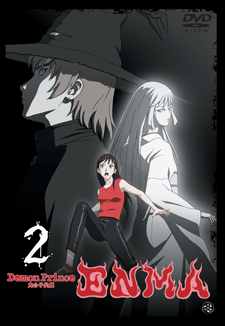
Anime Spotlight: Demon Prince Enma Volume 2 Released by Bandai Visual
Speaking of OVAs, Demon Prince Enma is one of the rare direct to video series to be produced this decade. The two episodes of this disc comprised the second half of the series, which pull in a couple of the work's incidental characters for a strange, sudden left turn. The Elfen Lied team of director Mamoru Kanbe and writer Takao Yoshioka move away from the cute chick bloodbath of the first two episodes. After bushwhacking the leads, the series settles into a hauntingly effective set piece for the rest of its run. As the title would suggest, the star of Demon Prince Enma is ostensibly the adult version of the demon prince who was once the bratty child hero of Go Nagai's children's horror adventure Dororon Enma-kun. The original series was a short, but memorably designed work from the dirty uncle of manga and anime. It's never been translated for a North American audience, so unless you've search eBay for Go Nagai merchandise, it probably escaped notice. As in his previous engagement, Enma is on Earth to collect errant demons, and he's accompanied by ice demon princess Yukihime, Grandpa Chapeauji, a sleeping old man demon who takes the form of Enma's witch's hat, and their guide to the human world, water demon/kappa Kapaeru. The distinguishing characteristic of episodes that feature Enma and company is that these supernatural mystery solvers have no regard for the human victims of their supernatural prey. At best, the afflicted humans are clues to the whereabouts of the hunted demons. These are the politically and physically powerful aristocracy of the demon world, and now they are at the sexualized celebutante age. As such, they are disinclined to help humanity, which was never their job to begin with.Episode three features what passes for a team falling apart. Yukihime isn't holding up well under the heat, and sports a strange bruise on her chest. Kapaeru has gone native and become concerned about the welfare of a young girl with whom he has been exchanging text messages. Enma is oblivious to the concerns of these two and has himself become bored and sloppy. As the group stumbles into a threat, the action is in keeping with the first volume's vicious, overtly sexualized take on modern urban horror. There's child abuse that paints the walls red as it spirals into a slasher scenario. There's a demon given birth out of a woman's mouth. As the reed flutes wale, the results are as visually disturbing as anime horror gets. Post FUBAR, the anime leaves Enma and company. The bridge to this final phase is two characters who had been pursuing Enma: raging police investigator Abashiri and spunky supernatural journalist Yuri Benten. Along with young college student/hikers Ayu and Hiroko and gangly high school teacher Yoshinaga, the pair find themselves trapped in a mansion. The haunted house is well fit into the OVA format, with the latter part of episode three used to establish the premise and the 40 minute episode four to run with the claustrophobic madness. With CG models, and an eye for baroque design, there is a discernible sense of space, but closed, stifling space. It's unusual for anime to create a an atmosphere of horror that is not urban, not gothic and not fantasy, but Demon Prince Enma manages it with powerfully eery results. Ayu, Hiroko and Yoshinaga largely serve to illustrate the nature of the haunted house, but the anime has some surprising twists in store for Abashiri and Yuri. Without simply going the route of role reversal, the damage done to Abashiri turns out to be quite severe, and despite her cheeky look and occupation, Yuri has moments in which she demonstrates a mad intensity that a Go Nagai fan would expect from one of his male characters. It's not just the depth here that is a welcome enhancement to the series. Considering the creators involved, and some of the key imagery of early episodes, there's surprising restraint. Namely, Yuri loses her clothes, and rather than detracting from the tension by ogling at the character, she spends time naked without the anime working to reveal her body. Ultimately, the themes that connect the haunted house to the prior cases in the anime are disturbingly dire. Anyone would hoped to be forgiven for the crimes for which the victims of the haunted house are damned. In the "dead wet girl" Japanese horror tradition, these victim/perpetrators are punished less for violating some taboo or capital offense, than they are for human failings. Enma's role underscores the off-putting premise of the series: there's no justice in the universe, no appealing for leniency and no hero to right the scale.
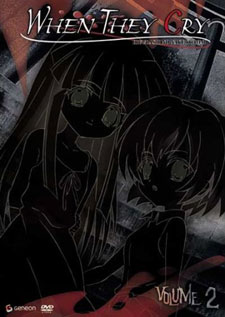
Anime Spotlight: When They Cry Volume 2 Released by Geneon
The aims of When They Cry fits in well with Hollywood's recent thrust of torture horror. Blocks of its episodes have opened with a flash forward to some gruesome crime. Partially obscured with an oil-slick like haze, a crazed, devoid of all reason character cackles as they slaughter other personalities from the series. The alternative opening has been a prologue situated in a spot away from the central action, focusing on the discovery of a mangled body. With this point of torment established, the stories count down to a severe act of violence ( someone tied down in a dungeon, about to get a nail hammered into each knuckle) played out by the members of a cast of characters who look suited for high school hijinks rather than bloody murder. Especially for anime fans, there is some novelty in using familiar personality models for such a violent mystery, and in arranging the pieces, then burning them down in regular conflagrations, When They Cry, sets, then delivers on an expectation. The male lead, Keiichi Maebara is the typical point of view character for these types of stories, and in keeping with the fashion of the genre being exploited, all the female characters develop affection for him. His personality oscillates wildly depending on how the situation should be played to advance the plot. He's archaically polite, or jaw-droppingly rude. He's craven and driven by self-preservation, or he's noble and self sacrificing. The girls who latch onto him include cuteness obsessed peer Keiichi include Rena Ryugu, the busty, older tomboy, Mion Sonozaku, the rambunctious younger sister type Satoko Hojo, and the proper young girl Rika Furube. The anime is set in a rural village that still has an uneasy relationship with the outside world, and which is still bitterly divided by a proposed damn project whose flooding would have taken the community off the map. It's story runs in the days leading up to the villages Cotton Drifting Festival, which features a ritual preparation of cotton that the villagers place onto the surface of the local river. Tufts of cotton floating down a river is a pleasant spectacle, and noh-like ceremony of the lends it some interesting atmosphere, Except, in recent years, every Cotton Drifting Festival has been marked by murder and a disappearance.The first four episodes of the anime, known as "Demoning Away" took events through the festival, and ended with one of the anime's trademark scenes of carnage. After that, the narrative would have been in an irreparable state. In fact, the next episode jumps to the days leading up to the festival with the start of another story with the same characters in the same time frame, this time dubbed "The Cotton Drifting Festival." In turn, that story completes in this second volume, and "Curse Killing" starts. In each iteration, characters don't seem to remember their previous fate, but information that was revealed during the course of the previous cycle is remembered, such that it does not have to be re-introduced. Anime in which the source of origin does not explain the nature of the anime itself are rare. If a sweet anime about a young female character is based on a manga for 18 year old males, that information will offer key insight into what that anime is hoping to achieve. When They Cry is part of a growing minority of anime that is based on visual novels, which are interactive narrative games, generally for the PC, not unlike the Sierra/Lucas Art ect adventure games that used to be popular in North America. Each story in the When They Cry anime corresponds to a game in the Higurashi no Naku Koro ni visual novel series. The visual novel background translates to geek skewing to the appeal. This includes visual touches such as cosplay cafes, where waitresses dress up in frilly, fanciful costumes, or it shades storytelling, such as the chooser you date romance thumb print on the character interactions. As does the warped chivalry of moe, which is especially creepy when it manifests in local doctor/baseball coach professing to a desire to adopt/marry Satoko. The complement to the ticking time bomb of violence is the mystery of explaining why everyone is on the brink of homicidal madness leading up to the Cotton Drifting Festival. Besides the players involved, the genre fan spin here, is the conceit of an iterative story, as well as factors like twins and rumors of the supernatural. The second volume break away from the reliance on a rabid dog fear of cute girls who are on a hair trigger towards violence. While that is still a factor, given an introduction to the factions, and history involved, attention to the anime is turned to cataloging and collating clues. As the mystery starts looking like it can addressed by pondering who is in what place at what time with what motivation, the anime becomes something of a cerebral exercise. If killer cuties and a mystery to think about are enough for you, When They Cry should make for an exciting anime series. However, the subversiveness that might be suggested by offering a lethal twist on genre archetypes isn't present. The anime has not evidenced any real opinion or outlook, except maybe for "watch out for mad dogs." It has lightened up on vilifying girls and country folk, but it's mentality still seems to be towing the conventional line. Especially compared to the best horror manga works, When They Cry is missing a revolutionary edge.
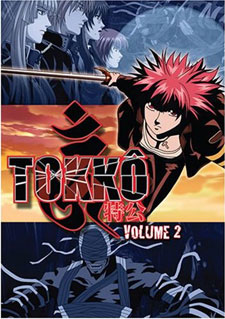
Anime Spotlight: Tokko volume 2 Released by Manga Video
At least Tokko doesn't take itself too seriously. What sets the series apart from middling action/horror anime is that it is based on a manga by Great Teacher Onizuka creator Tohru Fujisawa. His bleached hair-hijinks and career entrenched adults acting like highschool students is an odd fit for an often serious, sometimes bloody monster hunt, but the misfit makes the series that much more campy. It's an anime that stars a detective with bleached hair and orange tips who plays house with his sister (also a uniformed police officer). He works with people like a woman, again with dyed blonde hair, who wears an open leather jacket with nothing under it, and of course, the anime has no problem centering the view on her chest if she happens to have a conversation with the jacket off. Then, as if to ensure the sleaziness, it includes sexual reminders in its monsters: crawly white jumping facehuggers, or ghouls in bondage gear. This might not be so bad it's good, but it is sufficiently comfortable in, what could pejoratively be called comic-bookishness that it is watchable. Even if its mythology conspiracies are unsophisticated, and the police with swords versus demons scenario is a bit ropey, the self recognition that the series is an older audience B title is endearing.Tokko is named for Japan's Tokubetsu Koto Keisatsu or Special Higher Police, who, prior to the American occupation, were charged with maintaining political stability. In Tohru Fujisawa's they are sword carrying cops who dress like the movie version X-Men and kill demons to collect the 108 fragments of a Hellraiser style box that opened the gates to hell. Its members are also the survivors of a massacre in which most of the inhabitants of an apartment complex were killed. Despite being a police inspector, the hero of the series, Ranmaru Shindo, has the mentality of an awkward teen. Yet, he is driven to exact revenge on whatever caused the apartment complex tragedy. In volume two, Ranmaru is informed that like the members of Tokko, he has a symbiot demon fragment that can lend him the power needed to fight other demons. The ambitiousness of 108 demons, along with different factions of symbiot is unnecessary for a manga that ran three volumes and an anime that ran 13 episodes. Especially for one that is as obvious as Tokko. Nine episodes in, it's been a long journey to get to a point that was apparent from the opening credits. There's no way that Ranmaru joining as a full fledged member of Tokko could be a surprise. Drawing it out has just meant more time with his like-minded, juvenile partner and his yazuka/cop boss. And, at least these characters are more unconventional than the members of Tokko, which include a stoic guy, a flirtatious girl and a sensitive girl, all of whom are exaggerated so much that they seem like deadpan parodies. Tokko functions as the light beer of anime anime. It offers the service of not being terrible. Action has improved this volume, with more fluid motion and complex choreography than just flashes of light as the members of Tokko swipes as foes with their swords. There's been bare breasts without the anime encumbering itself in pandering. The primary assets are that it will not inspire anger and it isn't impressed with itself. In this, it's fine anime for the sake of anime viewing.
